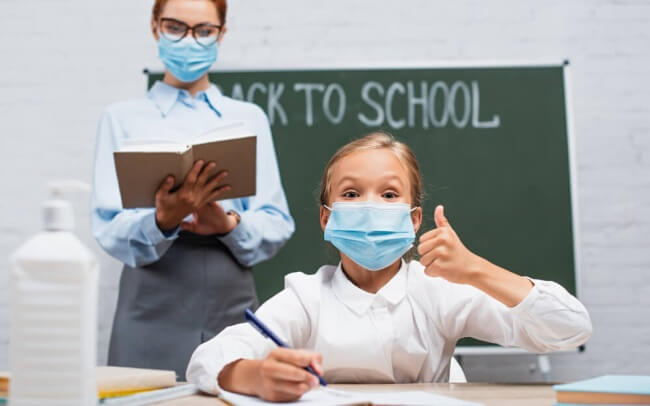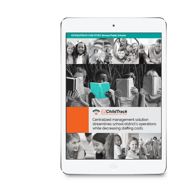
Providing school services during the COVID-19 pandemic poses a variety of challenges. The CDC and American Association of Pediatrics have provided recommendations and guidelines for returning to school, including the need for flexibility and planning.
These are the current guidelines for going back to school with COVID-19.
What Is It Called?The illness or virus is known by several names:
- Coronavirus/novel coronavirus
- SARS-CoV-2
- COVID-19
Coronavirus is a generic name for the type of virus. The official name is SARS-CoV-2. COVID-19 is the name of the illness caused by SARS-CoV-2. Many use all names interchangeably when speaking about the pandemic.
What Are the Symptoms?
The list of symptoms attributed to COVID-19 continues to grow, and individual illness varies. However, the following are the most commonly seen:
- Cough
- Shortness of breath or difficulty breathing
- Chills or repeated shaking with chills
- Muscle pain
- Headache
- Sore throat
- Loss of taste or smell
- Diarrhea
- Feeling feverish or having a measured temperature greater than or equal to 100.00 degrees
- Fahrenheit
- Known close contact with a person who is lab-confirmed to have COVID-19
The CDC recommends requiring parents to record each child’s temperature at home before dropping them off at the bus or school. Any temperature above 100.0 degrees Fahrenheit, coughing, chills, or other signs of illness are signals for the child to stay away from school.
How Does It Spread?
The virus that causes COVID-19 to spread is present in droplets of saliva that issue from the mouth when coughing, sneezing, speaking, singing, or breathing heavily as from exertion.
The virus particles are also present in nasal secretions.
People may develop COVID-19 from:
- Inhaling virus particles from the air
- Touching a surface with a high viral load then touching their nose, mouth, or eyes
- Receiving droplets to the face from someone coughing, sneezing, speaking, yelling, singing, or breathing heavily.
Some individuals may be infected with SARS-CoV-2 and experience mild or no symptoms yet still be able to spread the virus without knowing it. This is why it is critical to follow precautions whether illness appears or not.
Guidelines for Classroom Meetings
Both the CDC and the AAP provide the following guidelines for going back to school with COVID-19.
- Teachers, staff, and students wear double-layered cloth masks when medically and developmentally appropriate.
- Model and require frequent handwashing. Wash for 20 seconds with soap and water. If handwashing is not possible, use recommended hand sanitizers throughout the day, at least between each class, before and after eating, and after using the bathroom.
- Place desks three to six feet apart. If it is not feasible to place desks at least six feet apart, require masks to be worn.
- Teachers and staff remain six feet apart from other adults and children as much as possible.
- Teachers and staff limit in-person meetings with other adults and social distance at six feet when meeting.
- Limit the number of students in the classroom, cafeteria, and other spaces. Stagger class changes, implement one-way hallways, and serve lunch in the classroom.
- Use outdoor spaces whenever possible. The virus is less likely to spread in an outdoor setting.
- Use cohorts to keep students together in small groups that do not mix with others.
- Have teachers move from classroom to classroom and keep children in the same room all day.
The most important part of planning to go back to school during the COVID-19 pandemic is to remain flexible. If the number of cases and hospitalizations rises, your local health department or government may require schools to close and offer virtual lessons.
Cleaning and Disinfecting
Clean and disinfect high-touch surfaces such as desks, tables, chairs, sinks, and doorknobs. Perform cleaning and disinfecting daily at a minimum; clean as often as possible otherwise.
Use soap and water to clean the surface and prepare it for disinfecting. Use an EPA-approved disinfectant, a diluted bleach solution, or a solution with at least 70% ethanol to disinfect the surface. Follow all manufacturer instructions for using the disinfectant, including how long to leave it on the surface.
Do not allow students to share supplies. Clean and disinfect any shared toys or other items.
If Someone Becomes Ill
Develop and communicate your policy on what to do if someone becomes ill while at school. Consider where you may isolate students to await pick-up, how to disinfect spaces and items where the individual spent time, and how to notify those in contact with the individual.
At all times, follow the latest recommendations, guidelines, and orders from your local educational agency, health officials, and government. Nothing about life today is easy, but if everyone follows these guidelines, we hope to slow the spread and keep schools open.




